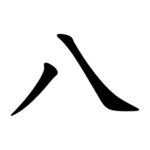| 八 | ||
|---|---|---|
| ||
| 八 (U+516B) "eight" | ||
| Pronunciations | ||
| Pinyin: | bā | |
| Bopomofo: | ㄅㄚ | |
| Gwoyeu Romatzyh: | ba | |
| Wade–Giles: | pa1 | |
| Cantonese Yale: | baat | |
| Jyutping: | baat3 | |
| Pe̍h-ōe-jī: | pat | |
| Japanese Kana: | ハチ hachi (on'yomi) | |
| Sino-Korean: | 팔 pal | |
| Names | ||
| Chinese name(s): | (Top) 八字頭/八字头 bāzìtóu (Bottom) 八字底 bāzìdǐ (Top, inversed) 倒八字 dàobāzì | |
| Japanese name(s): | (Top) 八頭/はちがしら hachigashira ハ ha (kana) | |
| Hangul: | 여덟 yeodeol | |
| Stroke order animation | ||
 | ||
Radical 12 or radical eight (八部), meaning eight or all, is one of 23 of the 214 Kangxi radicals that are composed of two strokes. "八" is two bent lines that signal divide. Eight is the single-digit number that can be divided by two the greatest number of times.
In the Kangxi Dictionary, there are 44 characters (out of 49,030) to be found under this radical.
八 is also the 11th indexing component in the Table of Indexing Chinese Character Components predominantly adopted by Simplified Chinese dictionaries published in mainland China. 丷 is an associated indexing component affiliated to the principal component 八.